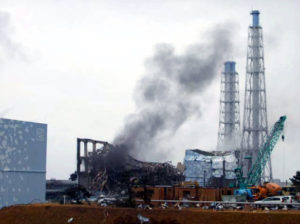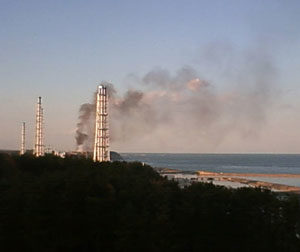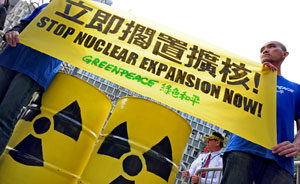Fukushima Fallout
By Mahir Ali | News & Politics | Opinion | Viewpoint | Published 9 years ago
It’s been over a month since a massive 8.9 magnitude earthquake and tsunami hit Japan on March 11, 2011. The images of the massive waves flowing across swathes of land pulling buildings, bridges, buses and boats with it are unforgettable. The nuclear disaster still unfolding at the Fukushima Daiichi nuclear power plant will be more so.
As of April 15, engineers were still working to stabilise the nuclear plant by pumping water into three damaged reactors in an effort to cool the fuel rods. Meanwhile, the government of Japan has ordered compensation for people affected by the damaged, radiation-leaking plant. But the consequences of the accident seem to get more threatening by the day.
On April 12, AP reported that “Japan’s nuclear regulators raised the severity level of the crisis at a stricken nuclear plant today to rank it on par with the 1986 Chernobyl disaster. An official with the Nuclear Safety Commission of Japan, speaking on national television, said the rating was being raised from 5 to 7 – the highest level on the international scale.”
However, a senior official with the IAEA in Vienna said while the ranking is on par with the infamous 1986 disaster the levels of radiation are not. “This is a totally different accident,” Denis Flory told a news conference on April 12. With Chernobyl, the radiation levels were far higher, he stated. Some reports have suggested that the radiation levels are one tenth of those of the accident that took place in Ukraine 25 years ago. The ranking deals with the size of the problem and the risk of severe consequences.
In the article below, Mahir Ali looks at past nuclear accidents, the safety of nuclear power and how the world is now reacting to the controversial “clean, green” energy.
– Online Editor
 The Chernobyl nuclear meltdown, which occurred 25 years ago this month in what was then the Ukraine Soviet Socialist Republic, has ever since been a touchstone for safety concerns over nuclear plants. Last month, following the devastating earthquake and tsunami in Japan, another name has entered the safety vocabulary: Fukushima, the location of nuclear site where the failure of cooling systems portended disaster, prompting evacuations and warnings of an impending apocalypse.
The Chernobyl nuclear meltdown, which occurred 25 years ago this month in what was then the Ukraine Soviet Socialist Republic, has ever since been a touchstone for safety concerns over nuclear plants. Last month, following the devastating earthquake and tsunami in Japan, another name has entered the safety vocabulary: Fukushima, the location of nuclear site where the failure of cooling systems portended disaster, prompting evacuations and warnings of an impending apocalypse.
The danger has not completely receded, nor has the degree of radiation leakage been properly assessed. Experts on the issue vacillate between worst-case scenarios and less ominous ones. Only time will determine the actual magnitude of the risk from radiation Japan and possibly many countries face. And then too, given the secrecy that usually governs such issues, we may never know the truth in entirety.
Japan’s initially understated reaction to explosions at the Fukushima Daiichi plant elicited a fair amount of international criticism. Tokyo’s concerns about not adding to the general panic unleashed by the natural disasters is understandable: it is always tricky in such situations to draw a line between adequately raising the alarm and disproportionate fear-mongering.
That one of the most scientifically advanced nations in the world had such a close call — amid what its prime minister described as the direst situation Japan had faced since the Second World War — inevitably set off a chain reaction, with China suspending approval for nuclear plants pending more rigorous safety regulation, and other countries reviewing their regulatory regimes. At the same time, the sheer folly of constructing such plants in the vicinity of geological fault lines was highlighted — even though in the case of notoriously quake-prone Japan, safety zones are strictly a relative concept.
Spokespeople for the international nuclear industry, meanwhile, lost little time in loudly lamenting the likelihood of Fukushima stalling the progress of what is often cited as the cheapest “clean, green” alternative to power generation from fossil fuels. Some environmentalists take essentially the same line, including the redoubtable British writer and activist George Monbiot.
Their argument is that whereas renewable resources such as solar and wind power are all very well, it is simply unrealistic — for economic and aesthetic reasons, among others — to posit them as a primary source of humankind’s energy needs. Which is to say the only viable alternative to nuclear power is the highly polluting coal-fired plants — and they will ultimately take far more lives than nuclear accidents, according to Monbiot. One can’t help being disturbed by the fact, though, that he drastically underplays the after-effects of Chernobyl to make his argument — claiming, for instance, that the disaster was directly responsible for no more than 50 deaths.
 It seems somewhat deceptive not to mention, in this context, the innumerable lives blighted by the contamination in terms of deformities and various other afflictions, and to ignore the fact that the effects of radiation were experienced not only across wide swathes of Europe and Asia but even reached as far as North Africa. Furthermore, an alternative calculus puts the number of Chernobyl-related deaths at close to a million. That is a huge difference, but it doesn’t automatically follow that the lower figure is more credible.
It seems somewhat deceptive not to mention, in this context, the innumerable lives blighted by the contamination in terms of deformities and various other afflictions, and to ignore the fact that the effects of radiation were experienced not only across wide swathes of Europe and Asia but even reached as far as North Africa. Furthermore, an alternative calculus puts the number of Chernobyl-related deaths at close to a million. That is a huge difference, but it doesn’t automatically follow that the lower figure is more credible.
If a credible case is to be made for investing in nuclear power as the main source of human energy needs, it must explicitly contend with, rather than gloss over, the ramifications of Chernobyl, Fukushima and Three Mile Island, not to mention any number of near-misses over the years. In a milieu where maximising profits is the primary motive, it is perhaps inevitable that corners will be cut in terms of safety, at least in the absence of more or less foolproof regulatory mechanisms. It is far from clear that such mechanisms are in place in the growing number of countries where nuclear energy plants are sprouting.
Last month, in the light of Fukushima, India’s Prime Minister Manmohan Singh announced a review of the ability of his nation’s nuclear plants to withstand substantial natural disasters. The announcement coincided with a comment from former chairman of India’s Atomic Energy Regulatory Board Adinrayana Gopalakrishnan who declared that nuclear safety management in the country is “worthless” and “mostly on paper.” “It is unlikely,” he noted, “that the kind of devastating earthquake and tsunami which hit Japan would strike any of the Indian nuclear plants. But the earthquake-resistant designs and tsunami-abatement measures … need a high-level, in-depth review by an independent expert group.”
It was noted, meanwhile, that the 2001 Gujarat earthquake created no emergency at the Kakrapar Atomic Power Station in that state, while the Madras Atomic Power Station safely shut down in the face of the 2004 Indian Ocean tsunami.
And a spokesman for the Pakistan Nuclear Regulatory Authority was quoted as saying that Karachi’s vulnerability to seismic events was being reassessed in the context of the city’s boiling-water reactor.
Of course, the trouble is that the worth of such assurances cannot properly be judged unless disaster strikes — and by then it’s too late for remonstrations.
 A careful distinction does, of course, need to be made between nuclear energy and nuclear weapons — even if one holds both to be disturbing in varying degrees. The safety of Pakistan’s growing arsenal of nuclear warheads has been the subject of considerable curiosity — and controversy — during the past decade, chiefly in the context of the risk that some of these weapons could fall into the hands of Islamic extremists. Occasional reports that fail-safe mechanisms have been put in place with American assistance invariably tend to be questioned or contradicted. The opacity is perturbing, but hardly surprising.
A careful distinction does, of course, need to be made between nuclear energy and nuclear weapons — even if one holds both to be disturbing in varying degrees. The safety of Pakistan’s growing arsenal of nuclear warheads has been the subject of considerable curiosity — and controversy — during the past decade, chiefly in the context of the risk that some of these weapons could fall into the hands of Islamic extremists. Occasional reports that fail-safe mechanisms have been put in place with American assistance invariably tend to be questioned or contradicted. The opacity is perturbing, but hardly surprising.
As Japan knows better than any other nation, nuclear weapons are an appalling invention, and the so-called “balance of terror” was never an adequate excuse for their retention. The activities of certain Pakistani personnel as serial proliferators were unconscionable, but proliferation more broadly was kind of inevitable, and it remains so. True, nuclear weapons have not been used since the largely gratuitous obliteration of Hiroshima and Nagasaki in 1945, but there have been a number of known close calls. It is also true that, following the chaotic disintegration of the Soviet Union, inadequately guarded segments of its nuclear arsenal did not, as was widely feared, fall into the hands of terrorists — but it is likely that considerable effort went into ensuring that outcome.
It can, of course, be perfectly logically contended that while nuclear weapons cannot conceivably be put to any morally defensible use, nuclear energy has the potential to become the mainstay of the endeavour to restrict, and hopefully reverse, global warming. But safety — both structurally, and in terms of the disposal of nuclear waste — is obviously a crucial issue. Without safeguards, toxic contamination is also a byproduct of many non-nuclear industrial processes. And safeguards eat into the bottom line, so controls are unlikely to be strictly enforced unless violations entail hefty penalties.
It is not unknown for industries to willingly pay penalties instead of reducing pollution because that happens to be the cheaper alternative. But there can be little doubt that, at least in some parts of the world, considerable progress has been made on this score, usually through strictly enforced legislation. It is contended that absolute safety cannot be guaranteed in the nuclear industry, but if its present rate of expansion is to continue, it must be accompanied by efforts to get as close as possible to fail-safe mechanisms and foolproof reactors.
It may well be the case that growing reliance on nuclear power turns out to be a grave error. I remain a sceptic with agnostic inclinations in this respect. Vast wind farms and masses of photovoltaic cells seem decidedly more appealing than the prospect of proliferating nuclear reactors, and it seems almost criminal not to invest in these technologies in lands where there’s no dearth of wind or sunshine. But with a layperson’s grasp of science (or lack thereof), one can only be on shaky ground in seeking to refute the contention that the scale on which such technologies would be required to quench humankind’s steadily growing thirst for energy is simply infeasible. And the continued widespread use of fossil fuels seems indefensible: even lobbyists for the coal and petroleum industries have, by and large, stopped denying their pollutive aspects. Furthermore, these are finite resources; besides, the damage wreaked on parts of the world in the quest to control the supply of oil barely requires reiteration.
Visions of nuclear power as the great panacea are nonetheless, troubling. In the circumstances, however, it would perhaps be best to view Fukushima as a warning that must be heeded, rather than as a barrier that must not be crossed.
Mahir Ali is an Australia-based journalist. He writes regularly for several Pakistani publications, including Newsline.


